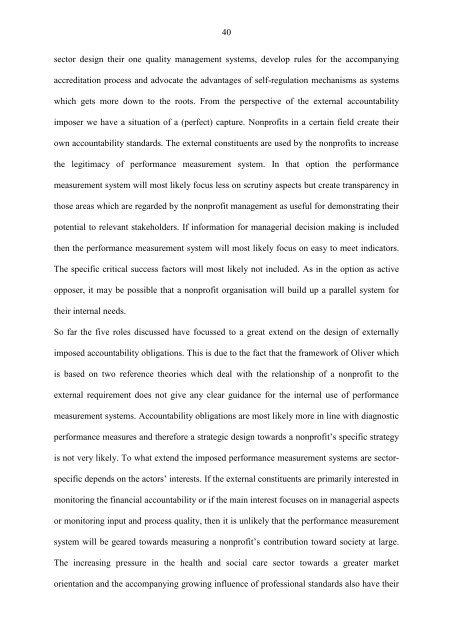Strategic responses to Performance Measurement in Nonprofit ...
Strategic responses to Performance Measurement in Nonprofit ...
Strategic responses to Performance Measurement in Nonprofit ...
You also want an ePaper? Increase the reach of your titles
YUMPU automatically turns print PDFs into web optimized ePapers that Google loves.
40<br />
sec<strong>to</strong>r design their one quality management systems, develop rules for the accompany<strong>in</strong>g<br />
accreditation process and advocate the advantages of self-regulation mechanisms as systems<br />
which gets more down <strong>to</strong> the roots. From the perspective of the external accountability<br />
imposer we have a situation of a (perfect) capture. <strong>Nonprofit</strong>s <strong>in</strong> a certa<strong>in</strong> field create their<br />
own accountability standards. The external constituents are used by the nonprofits <strong>to</strong> <strong>in</strong>crease<br />
the legitimacy of performance measurement system. In that option the performance<br />
measurement system will most likely focus less on scrut<strong>in</strong>y aspects but create transparency <strong>in</strong><br />
those areas which are regarded by the nonprofit management as useful for demonstrat<strong>in</strong>g their<br />
potential <strong>to</strong> relevant stakeholders. If <strong>in</strong>formation for managerial decision mak<strong>in</strong>g is <strong>in</strong>cluded<br />
then the performance measurement system will most likely focus on easy <strong>to</strong> meet <strong>in</strong>dica<strong>to</strong>rs.<br />
The specific critical success fac<strong>to</strong>rs will most likely not <strong>in</strong>cluded. As <strong>in</strong> the option as active<br />
opposer, it may be possible that a nonprofit organisation will build up a parallel system for<br />
their <strong>in</strong>ternal needs.<br />
So far the five roles discussed have focussed <strong>to</strong> a great extend on the design of externally<br />
imposed accountability obligations. This is due <strong>to</strong> the fact that the framework of Oliver which<br />
is based on two reference theories which deal with the relationship of a nonprofit <strong>to</strong> the<br />
external requirement does not give any clear guidance for the <strong>in</strong>ternal use of performance<br />
measurement systems. Accountability obligations are most likely more <strong>in</strong> l<strong>in</strong>e with diagnostic<br />
performance measures and therefore a strategic design <strong>to</strong>wards a nonprofit‟s specific strategy<br />
is not very likely. To what extend the imposed performance measurement systems are sec<strong>to</strong>r-<br />
specific depends on the ac<strong>to</strong>rs‟ <strong>in</strong>terests. If the external constituents are primarily <strong>in</strong>terested <strong>in</strong><br />
moni<strong>to</strong>r<strong>in</strong>g the f<strong>in</strong>ancial accountability or if the ma<strong>in</strong> <strong>in</strong>terest focuses on <strong>in</strong> managerial aspects<br />
or moni<strong>to</strong>r<strong>in</strong>g <strong>in</strong>put and process quality, then it is unlikely that the performance measurement<br />
system will be geared <strong>to</strong>wards measur<strong>in</strong>g a nonprofit‟s contribution <strong>to</strong>ward society at large.<br />
The <strong>in</strong>creas<strong>in</strong>g pressure <strong>in</strong> the health and social care sec<strong>to</strong>r <strong>to</strong>wards a greater market<br />
orientation and the accompany<strong>in</strong>g grow<strong>in</strong>g <strong>in</strong>fluence of professional standards also have their
















